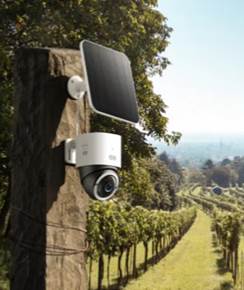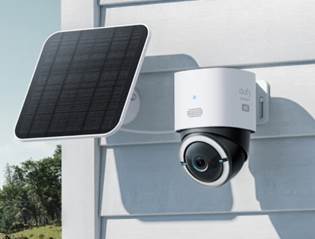Wireless
security cameras offer unmatched convenience, but frequent battery drain can
turn them into a frustrating chore. Many users find themselves recharging or
replacing batteries far more often than expected. The primary culprits include
excessive motion triggers, high-resolution video recording, poor signal
strength, and extreme weather conditions. Understanding these factors is the
first step toward optimizing your camera’s performance. In this article, we’ll
explore practical adjustments and maintenance habits to extend battery life
without compromising security.
Optimize Your Camera's Motion Detection Settings
Motion
detection is a major power drain if not configured properly. Cameras that
activate too frequently waste battery life on false alarms from passing cars,
swaying trees, or pets. To minimize unnecessary recordings, adjust the
sensitivity level to only capture human-sized movements. Many cameras allow you
to define specific detection zones, so you can ignore areas like busy streets.
Scheduling detection times—such as only enabling alerts during nighttime—also
helps conserve energy. Additionally, reducing the length of recorded clips
prevents the camera from staying active longer than needed. Fine-tuning these
settings can significantly cut down battery consumption while keeping your
property secure.
Smart Video Settings That Save Power
Video
quality and recording modes play a huge role in battery usage. High-definition
footage consumes more power, so consider lowering the resolution if your camera
supports it. A 1080p setting often provides sufficient clarity while being more
efficient than 4K. Switching from continuous recording to event-based recording
(only when motion is detected) can also make a dramatic difference. Some
cameras offer a "low-power preview" mode, which reduces live
streaming quality but extends battery life. Another useful feature is adjusting
the frame rate—lower frame rates reduce processing demands. Experimenting with
these settings allows you to strike the perfect balance between video quality
and battery efficiency.

Essential Maintenance Habits
Regular Firmware Updates for Efficiency
Improvements
Manufacturers
frequently release firmware updates that improve battery performance and fix
bugs. An outdated camera may consume more power due to unoptimized software.
Checking for updates every few months ensures your device runs as efficiently
as possible. Some cameras automatically notify you when an update is available,
while others require manual checks through the app. These updates often include
enhanced motion detection algorithms, better compression for video files, and
improved sleep modes. Skipping updates could mean missing out on critical
power-saving enhancements.
Cleaning Sensors and Lenses Monthly
Dust,
spiderwebs, or moisture on the camera lens or motion sensors can trigger false
alerts, forcing the camera to record unnecessarily. A quick monthly wipe with a
microfiber cloth keeps the lens clear and ensures accurate motion detection.
Pay special attention to areas where insects might build nests, such as around
the sensor housing. If your camera is exposed to rain or snow, check for water
droplets that could interfere with infrared sensors. A well-maintained camera
operates more efficiently, reducing wasted battery cycles on irrelevant
recordings.
Battery Care for Long-Term Performance
Extreme
temperatures can degrade battery health over time. If possible, position your
camera in a shaded area to avoid direct sunlight in summer and insulate it
during freezing winters. For rechargeable batteries, avoid letting them fully
deplete before charging—keeping them between 20% and 80% prolongs lifespan. If
your camera uses disposable batteries, opt for lithium-based ones, as they
perform better in cold weather than alkaline alternatives. Proper storage
during off-seasons (for removable batteries) also prevents deterioration. These
small habits help maintain battery efficiency for years.
Advanced Power-Saving Solutions
Solar Panel Options for Continuous Power
For
cameras placed in sunny locations, a solar panel accessory can eliminate
battery worries entirely. These panels trickle-charge the camera throughout the
day, providing near-continuous power without manual intervention. They’re
especially useful for hard-to-reach installations where frequent battery
changes are impractical. When choosing a solar panel, ensure it’s compatible
with your camera’s voltage requirements. Some models even include built-in
weather resistance, making them a reliable year-round solution. Solar power is
an eco-friendly way to maintain security without sacrificing convenience.

Battery Replacement vs. Rechargeable Options
Some
wireless cameras support swappable batteries, allowing you to keep a spare
charged and ready. This is ideal if recharging requires unmounting the camera.
Alternatively, models with built-in rechargeable batteries may be more
convenient but require downtime during charging. Evaluate your needs—if your
camera is easily accessible, rechargeable might suffice. For difficult
installations, quick-swap batteries ensure uninterrupted surveillance.
Third-party high-capacity batteries are also available for certain models,
offering longer life between charges.
When to Consider Hardwired Alternatives
If
battery life remains a persistent issue despite optimizations, a hardwired
camera could be a better fit. These models draw power directly from an
electrical outlet, eliminating battery concerns altogether. While installation
is more involved, they provide uninterrupted recording and often support
higher-resolution video. For renters or those who prefer flexibility, a hybrid
approach—using a wireless camera with a solar panel—can offer the best of both
worlds. Assess your property’s power access and security needs before
deciding.
Conclusion
Maximizing
your wireless camera’s battery life involves smart settings, regular
maintenance, and sometimes alternative power solutions. By fine-tuning motion
detection, optimizing video settings, and keeping hardware in good condition,
you can significantly reduce charging frequency. For those seeking hassle-free
security, brands like eufy offer high-quality cellular security camera options, including solar-powered models that ensure
continuous operation. With a variety of designs tailored to different needs,
you can find the perfect balance between convenience and reliable surveillance.
Investing a little time in optimization today means fewer battery headaches
tomorrow.
